|
|
|
|
Strategic Analysis:
A Monthly Journal of the IDSA
The Baltic States' Search for Security
Nivedita Das Kundu
*
Abstract
The Baltic States' search for security became a major issue after their independence in 1991. Since then these States have been trying to establish links with Europe and perceive Russia as a major threat. Their aspirations for the NATO membership are based on their security perspective. Baltic States are engaged in trying to upgrade their armed forces, solve their territorial and ethnic disputes to meet the NATO membership criteria. As regards relationship with Russia, there are problems on number of issues and they are trying to resolve them, as a normal friendly relationship between them will be beneficial for both sides.
Introduction
The three Baltic States, Estonia, Latvia and Lithuania came into prominence when Soviet Union underwent fundamental changes. The communist bloc broke away resulting in the disintegration of USSR there by paving way for the formation of a number of new countries. During the days of the August 1991 coup, the Russian and Baltic leaders took an anti-Soviet position helping democracy to win. Immediately thereafter, Estonia, Latvia and Lithuania proclaimed their independence. The Russian leadership supported this event by accepting them as sovereign states and recognised their independence on September 10, 1991. A month later United Nations also recognised them as three independent countries.
All these states are today neighbours of Russia. Estonia is spread over a territory of 45,227sq.kms. It has the Baltic Sea in the north and west, Russia in the east and Latvia in the south. Its other neighbours across the sea are Finland and Sweden. Latvia is spread over a territory of 64,589 sq.kms. Latvia's border countries in the northeast are Estonia and Russia and Belarus and Lithuania in the South. Its north and northwest borders are surrounded by the Baltic Sea. Lithuania is spread over a territory of 65,200 sq.kms. It has a common border in the north with Latvia, in the southeast with Belarus, in the south with Poland and in the southwest with Russia (Kaliningrad). On its West Lithuania is surrounded by the Baltic Sea. 1 (For Baltic statistics on the three Baltic states, refer to Annexures 1 and 2, pp. 479-485).
According to a secret protocol under the treaty of non-aggression (the Nazi-Soviet or the Molotov-Ribbentrop pact) signed between Germany and the USSR on August 23, 1939, the Baltic States were placed under the Soviet sphere of interest. Lithuania initially was to be the part of the German sphere of influence. However, Nazi-Soviet treaty on friendship and existing borders, following the outbreak of the Second World War, permitted USSR 2 to take control of Lithuania. In October 1939 Soviet troops entered the territory of Baltic States and in June 1940, the Soviet Union occupied all the Baltic States which remained as part of the USSR from 1940 to 1990. 3 The collapse of Soviet Union in 1990 created favorable conditions for the Baltic States. However, mutual relationship between Russia and the Baltic states turned out to be rather complex and sometimes even tense.
Baltic states joined the PfP (Partnership for Peace) programme in 1994 and have openly stated their wish for full fledged membership in NATO and the European Union. The Baltic dimension has become an important component of the European security debate. At the same time the Baltic security dilemma and the ability to solve it is being described in terms of the litmus test metaphor. The Baltic security dilemma has had an impact on the whole North-East European region, with consequences for Scandinavia, continental Europe, the European Union, Russia and NATO. This region is a kind of historical laboratory, a meeting point of modernity and post modernity where new principals of international relations are being formed and put to test.
The analysis of this article is based on the hypothesis that political reality of the Baltic states may be conceptualised as an interplay of at least two competing discourses, i.e., the discourses of sovereignty and the discourse of integration, which reflect different discursive practices. The sovereignty discourse is related to nation/state identity and to the politics of exclusion, while the integration discourse is tied to the globalisation and integration processes in the Baltic States.
Security Concepts
The Baltic states, like other post-communist states, are implementing a transition in which they are attempting simultaneously to create new states and nations, to establish new political Institutions based on the rule of Law, and to build the foundation for an effective and productive market economy. In this transition process the issue of the formation and reformulation of the problems of security (i.e., their construction and reconstruction) has a major role. 3 This article analyses the security concepts of the Baltic states, by answering questions like what are the referent objectives for security? How are the main dangers, risks and threats for security being identified? How security conceptions are related to the security process? The analysis is done mainly based on the official documents which define security and foreign policies. In Lithuania it based on the 'Basics of National Security of Lithuania' adopted in 1996, in Latvia, on the 'Security Concept of the Republic of Latvia' adopted in 1997 and in Estonia, on the 'Guidelines of the National Defence Policy of Estonia' adopted in 1996.
Lithuania: Basics of National Security of Lithuania
The 'Basics of National Security of Lithuania' (BNSL), adopted in December 1996, was prepared by a task group created at the end of 1994. The group consisted of representatives from all the parties represented in Siemas, and so the final document expressed the common attitude of Lithuania's political elite towards the issue of national security. During the years between the first draft of the conception and the adoption of the document by Seimas, Lithuania's foreign and security policy acquired a distinctly pro-western orientation. Membership in NATO and the EU came to be seen as the means of ensuring national security. 4
The referent objects for national security are: citizen's rights, fundamental freedom and personal security, the cherished values of the nation, its rights and conditions for free development state independence, constitutional order, the integrity of the states territory, environmental and cultural heritage. 5 Here one can easily identify the levels of securitythat of the individual person, the nation and the statewith preferential treatment of the nation.
The threat is based on a clear-cut dissection of political reality into the inside ('We') and the outside ('Other'). The 'we' in the document are the Lithuanian state, an integral part of the community of European nations the Baltic states, the European Union, the countries of Central and Northern Europe. 'Our' space is characterised in terms of integration, co-operation and collaboration. The 'other' are the States of unstable democracy, such as Belarus and the territory of the Kaliningrad district. Their threatening character is presented as an objective reality, as a result of the specific geopolitical environment, hardly predictable due to the existence of militarised territories. Relations with the 'other' are characterised in terms of threat prevention, including the prohibition of joining in any form, any new political, military, economic or any other inter-state alliances or commonwealths established on the basis of the former Soviet Union and the endeavor to demilitarise the Kaliningrad region and to encourage its development, provide this development does not contradict the interests of Lithuania. 4 In defining the threats to the state's territorial integrity and sovereignty security is subdivide into political, military, economic, ethnic and criminal sectors. 4 That is the document is based on an extremely wide yet detailed concept of security.
The most prominent feature of the documents is the partition of the security space into the zone of peace and the zone of potential conflict, The concept of security that is employed is clearly within the meaning of sovereignty discourse. 5 The conceptualization of security in the document is essentially based on the paradigm of realism. Security is conceived as preservation of the permanent and unchanging entity (the nation, the state) by discovering the threats it faces and neutralising them by political and military means. 5 These ideas are squarely within the sovereignty-based discourse. The goal of integration with the West is still based on the meanings, which have been shaped in the Sovereignty discourse is being transferred to the emerging integration course.
Fig.1 Political Map of Lithuania
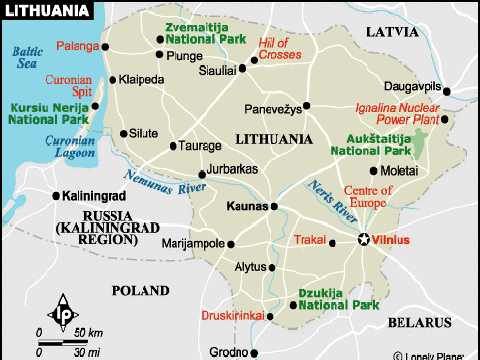
Source: http://www..lonely planet.com/mapshells/Europe/Lithuania/Lithuania.htm
Latvia: Security Concept of the Republic of Latvia
The Security Concept of Latvia belongs to the same period as Lithuania's Basics of National Security and it can be treated as a stage in the construction of Latvia's political identity. The document starts with the "Latvia's national security is in protection and preservation of its states sovereignty, territorial integrity, language and national identity, democratic regime as provided in the constitution, market economy and human rights and protection of public and private interests." 6 The list of the referent objects of security is a mixture of the sovereignty and the integration discourses. References to state and the nation ('language and national identity') can be attributed to the sovereignty discourse, while the claims concerning the protection of market-economy and human rights are expressive of integrating and globalising tendencies. 6 The emphasis on language as a special concern of security can be interpreted as determination to pursue certain nationalist policies, despite unfavorable international reaction to the country's laws on citizenship and language.
The list of threats mirrors the position Latvia occupies as the middle Baltic States. Situated between Lithuania and Estonia, this country has no borders with any Western state, but has along border with Russia and Belarus. The threats, as listed in the document, are not explicitly associated with any particular state, yet their quality is such that one can easily identify some sensitive points in Latvia's relations with Russia. These include Latvia's economic dependence (particularly for energy resources) on Russia, Russia's opposition to Latvia's integration with transatlantic structures and the tension between Latvia and Russia caused by the alleged violation of Russian speaking minorities rights in Latvia. 7
Like other Baltic states after fifty years of occupation Latvia was faced with the choiceeither to get reconciled with the fact that "the injustices inflicted on them have turned them into binational states and there is no way of turning the clock back", or to make an attempt at rebuilding the nation-state grounded on national values. Specifically, the first alternative could have meant the adoption of the so-called zero-option law on citizenship (adopted in Lithuania in 1998, according to which all those resident in the country at the time of the declaration of independence acquired citizenship rights, recognition of two official languages, etc. The other alternative would imply some mixture of the ethno politics of exclusion and recognition of certain universal human rights. The choice of this Baltic state was essentially the latter alternative. 8 So, it is no wonder that the Latvian language has become the referent object of security. It is namely this direction of state and nation building that finds expression in Latvia's security conception.
Fig.2. Political Map of Latvia

Source: http://www.rec.org/REC/Maps/Lat-map.html
Estonia: Guidelines of the National Defence Policy of Estonia
In 1996 Estonia's Riigikogu (Parliament) adopted the Guidelines of the National Defence Policy of Estonia. Some of the statements of this small document help clarify the details of the security concept employed in Estonia's official political discourse. The document asserts, "The security of all states is indivisible and the security of no one state can be achieved at the expense of another state". 9 The document relates Estonia's security to general security conditions in the Baltic Sea region and also to close defence-related co-operation with Latvia and Lithuania. Full membership in the North Atlantic Treaty Organisation (NATO) and the Western European Union (WEU), 9 is the main political and practical vehicle by which Estonia can develop and strengthen its security and national defence.
The document lists the following security objectives and defence policies: independence and sovereignty of the state, the indivisible integrity of its land area, territorial waters and airspace, its constitutional order and the vitality of its people. The threats are defined in one sentence: "The main sources of danger threatening states security are aggressive imperial aspirations and political and military instability." 10 This definition, as in the case of the two other Baltic states, clearly relates to the problem in Estonia's relations with Russia.
The general approach of the document indicates that in the official Estonian political discourse the meaning of security is more akin to that of global, rather than national security. Specifically, this means that the sensitive issues in Estonia's transition process are not being conceptualised only in terms of state or nation security, but are rather made issues of civil political society. This understanding of security counteracts the usual tendencies of securitisation in the state building process.
Orientation to co-operative security is noticeable in all Baltic States and it is manifested in the National Defense Concept of Latvia (1999), Military Defence Strategy of Lithuania (2000) and National Military Strategy of Estonia (2001). 11 In all of them it is emphasised that the national security and defense system of the Baltic states is to be developed as part of common European and transatlantic arrangements. These conceptions have been reflected in the security policies of the Baltic States.
Fig-3.Political Map of Estonia
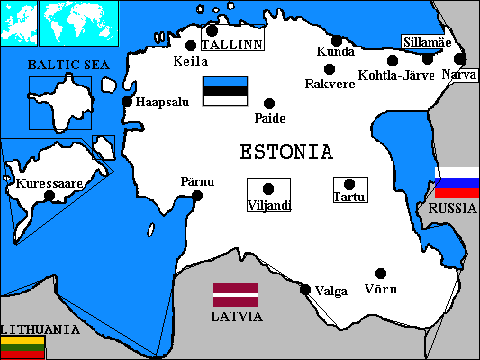
Source: http://www.ciesin.ee/ESTONIA/map.html
Security Policies
In terms of political and military security arrangements the Baltic States had the following choices: neutrality; an alliance of the Baltic states; and integration into Western security and political structure, i.e., NATO and EU membership.
Neutrality
Neutrality, according to which precludes membership in military alliances and prohibits ties with other countries beyond a low threshold of integration. 12 All three Baltic states have experienced a period of a positive attitude towards neutrality. Although it was never officially adopted, neutrality was quite a popular idea in the political discourse of 1989-1991 and it remained a live option until 1994. 13 However, it was adjudged as a dangerous policy later.
In the Baltic states neutrality was first associated with the peculiarities of the construction of nation and state identity. In the early 1990s, when constructing their political identities, the Baltic states still conceived themselves as situated in bipolar world, in between the two cultural and political poles: the East and the West. Geopoliticaly, they considered themselves as small and weak states on the borderline between two different cultural traditions: European Catholic and Protestant culture (the West) and the Slavonic-Byzantine cultural tradition (the East). 14 In this context neutrality was quite naturally associated with the metaphor of the Baltic States as the bridge between the East and the West.
It is quite natural that neutrality as a security policy option was popular at the time of liberation movements and immediately after the restoration of independence. For, this was the period when the problem of national and political identity, closely related to issues of foreign and security policies. Identity issues were urgent not only for the Baltic states but also for Russia and NATO. 15 The positive attitude to neutrality was also encouraged by Russia's progress in 1991-92 towards the concept of liberal state identity.
The issue of neutrality of the Baltic states was raised once again by Russia in 1997-1998. Early in 1997 Moscow came up with the 'Baltic concept', which can be considered as Russia's response to Baltic states' declared intention to join the NATO. The document was explicit about Russia's interests: non-allied status of the Baltic states, economic and cultural co-operation, border co-operation and the citizenship issue. The document envisioned the traditional role of the Baltic states as Russia's cordon sanitaria. A trade-off involving the Baltic states' renouncement of NATO membership in exchange for the guarantees of their security needs was proposed. The border treaty with Lithuania was signed in October 1997. After NATO's Madrid meeting (July 1997), with the Baltic states' intention to sign the US-Baltic charter, Russia's officials emphasised that the only basis for Baltic security was the preservation of their status outside blocs. 16 In exchange for non-alliance President Boris Yeltsin proposed Russia's guarantees for the security of the Baltic states through their establishment of regional security arrangements, the so-called cross-security guarantees. 17 Russia also proposed to establish a regional security and stability Pact based on the principles of the Organisation for Security Cooperation in Europe (OSCE).
All of those proposals were rejected by the Baltic States. At the end of 1997 president of the three Baltic States announced in a joint communiqué that unilateral security guarantees do not correspond to the spirit of new Europe and that such guarantees, as well as regional security pacts, had never been on the agenda of Estonia, Latvia and Lithuania. 18 It was perceived by the Baltic states that such a demilitarised zone would leave the Baltic States exposed and vulnerable and allow Russia the advantage to station forces in the geopolitical proximity without a counterbalance from the West.
Alliance of the Baltic States
By 1994 all the Baltic States recognised that the idea of neutrality was dangerous and unacceptable. So, it was natural that in January 1994 Lithuanian President Algirdas Barzauskas emphasised co-operation among the Baltic states as a top priority of Lithuania's foreign policy. In 1994 in Tallinn the Baltic Countries signed the Agreement on Baltic Parliamentary and Government Cooperation between Estonia, Latvia and Lithuania. The Agreement included the following framework for cooperation: the Baltic Assembly (founded in 1991), the Baltic Council of Ministers (established in 1994) and the Baltic Council as joint bodies for the governments and the parliaments. In addition, the three heads of states meet regularly, at least once a year, and there are frequent contacts between the ministers. 19
The issue of building the Baltic defence alliance was raised at the sixth session of the Baltic Assembly (Riga, April 1995). Later, in August 1996, a group of Estonian politicians issued a joint statement calling for a Baltic Security Pact that would help maintain the security of the Baltic States till their admission to NATO. According to the data of the 'Baltijos tyrimai' (Baltic survey) of January 1996, more than half of the population of the Baltic countries supported the creation of a military alliance of Lithuania, Latvia and Estonia: the percentage in Lithuania was 69, in Latvia 67 and in Estonia 64 per cent of those surveyed. 20
One can say in retrospective that the whole idea was a rehearsal of the past, an attempt to remake history by restoring the failed inter-War defence alliance of the Baltic states'. It can also be seen as a response to the Russia's opposition to Baltic states' membership in NATO and as the Western reservation and skepticism concerning this membership. 21 However, the fact that the idea did not take root in the political discourse of the Baltic States can be explained not only by external causes, but also by the fact that the idea of a Baltic identity did not resonate with core elements of older narratives of their political identities. Estonia, Latvia, Lithuania, being put in the same basket by fifty years of the common Soviet past, are united not so much by a positive self-identification, but rather by a construction of a common danger. That explains the similarity of their key security policy optionintegration into Western security and political structures.
The Western Option
The pro-Western orientation of the Baltic states' security and foreign policy is unambiguously demonstrated by their quest for membership in the main Western intergovernmental organisations EU and NATO. As has been noted, because of the dominance of the sovereignty discourse related to the construction of the nation-states identity and to the neorealist conception of security the justification of such membership is primarily instrumental. 22 After regaining their independence the Baltic States have been constructing their political identities in terms of the East/West opposition. They have been creating narratives of belonging to the West and a narrative of the East as the Baltic's threatening other. The narratives legitimize their foreign security policy of integration with the West are highly value-loaded, with the West being associated with prosperity, security and democracy, whereas the East linked with poverty, non-predictability, insecurity. 23 Geopoliticaly, the West is associated with the EU and the NATO countries, the East with the CIS, mainly with Russia and Belarus.
Identification with the West is manifested by active participation in many Western political, economic and security organisations. The Baltic States are full member of UN, Council of Europe, Organisation for security and cooperation in Europe, Euro-Atlantic Partnership Council, and World Trade Organisation. The Baltic states have been invited to commence talks for joining the EU (Estonian 1997, Latvia and Lithuania in 1999). They are associated partner of Western European Union. In 1994, after the withdrawal of Russian troops, the Baltic States applied for full membership in NATO. The NATO's response to the aspirations of the candidate countries came in early 1994 in the form of an invitation to participate in the Partnership for Peace (PfP) Programme. 24 The Baltic States were invited for the full NATO membership at the Prague summit in 2002 and by May 2004 they will be the full member of NATO.
NATO Membership
NATO membership is based on a broad concept of security, embracing political, economic as well as defence components. For those seeking membership in the alliance must settle their disputes on ethnic or territorial issues or internal jurisdictional disputes by peaceful means. Resolutions of such disputes are the factors, which determine whether a state is to be invited to join the alliance, or not. Another important condition is that the applicant countries military capability should contribute to NATO's collective defence. Baltic states' NATO membership is a deliberative project based on certain normative principles. The changes that have taken place in the Baltic states as a result of their attempts to meet NATO membership criteria are mainly related the military capabilities and territorial and ethnic disputes.
Military Capability
The Baltic states had no armed forces separate from those of the USSR, until independence (in August 1991). 25 However, these States have made substantial progress since they began building their defense forces from zero base line immediately after the restoration of independence. In Latvia, the Ministry of Defense was established in November 1991, in Lithuania in April 1990 and in Estonia in April 1992. 26 The building of national defense forces proceeded in two closely linked directions: independent defense based on the defense structure of the state and international defense cooperation aimed at developing collective security in Europe.
Table-1: Defence Capacity of the Three States Till 2001

Source: The Military Balance 2002-2003, 2003 UK: Oxford University Press, pp.71-75 & SIPRI Year Book 2001, Armaments, Disarmaments and International Security, pp. 274-275.
All the three states plan to increase defense expenditure to 2.0 per cent of their GDP by 2003, for integration into NATO. Having joined the Partnership for Peace Programme (PfP) in 1994 the Baltic states made sustained efforts towards meeting NATO requirements for the interoperability of their defence forces with that of NATO. Since 1995, they have been participating in the planning and reviewing process (PARP), submitting after every two years detailed reports on their defence policies and defence structures. They have given a lot of attention to defence-related Baltic co-operation aimed at strengthening self-defence capabilities and contributing to the NATO integration process. 27 Baltic defence-related cooperation is based on defence cooperation agreements and a set of joint defence cooperation projects.
Four of the major cooperative projects of the Baltic States are:
The BALTSEA project of Baltic, Nordic and other partner countries has been launched with the aim of coordinating defence and security assistance to Estonia, Latvia and Lithuania. The Swedish-Baltic joint project to modernise the military registration system and mobilisation of database, called BALTPERS, has also been established. 29
Territorial Disputes
Border Agreements
Estonia and Latvia concluded an agreement in 1992 on the re-establishment of the state border. The agreement re-confirmed their land border. However, the sea border agreement was signed only in 1996. This delay was caused due to the conflict of interests over commercial fishing rights. However, the problem was solved in 1997 by signing a separate agreement on fishing rights. The signing of the sea border agreement between Latvia and Lithuania also prolonged even though the land border agreement was signed in 1993 and was put in force in 1995. The sea border agreement was signed in 1999, but has still not been ratified by Latvia's parliament. 30 Just as in Estonia, in Latvia's case also, the sea border dispute is related to the conflicting economic interests concerning oil and fishing rights. The heart of the matter is that in the disputed area of the Baltic Sea shelf there is a promising amount of oil deposit on which both Latvia and Lithuania lay their claims. Latvia has negotiated with foreign companies on the exploration and possible exploitation of these deposits. The positive turn in the negotiation was reached when the legal and economic aspects of the issues were separated. This development was also influenced by the NATO requirement making membership in NATO conditional on signing of a treaty on border delimitation. Positive changes are usually prompted by integration process and for requirements for membership in NATO. One can easily discern the connection between NATO summits and Baltic states' attempt in solving their border disputes. In 1994, the NATO Brussels summit encouraged the revision of Lithuanian-Polish relations. In 1997, NATO Madrid Summit was a stimulus to Estonia and Latvia to drop their demands of including the treaties of 1920 in border agreements with Russia. And in 1999, NATO Washington summit was a stimulus for Lithuania and Latvia to sign the sea border agreement. 31
Fig-4: Border Demarcation Among Baltic States and Russia
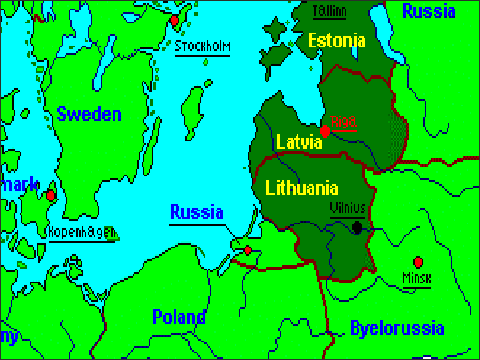
Border issues with Russia
All Baltic states have borders with Russia. Border disputes between Russia and Estonia and between Russia and Latvia began immediately after their declaration of independence. 32 The two republics wanted back the territories, which were assigned to them by the 1920 peace treaties with Russia. Both Estonia and Latvia assumed that the treaties were still valid, despite the annexation of both republics by USSR in 1940. 33 However, Russia considered them a matter of bygone history.
Estonia, in November 1996, and Latvia, in February 1997, gave up their demands for the inclusion of reference to the 1920 peace treaties at the time of border agreements with Russia. 34 Since 1997, it was agreed by the Foreign Ministers of Latvia and Russia that the border agreements were ready for signing. 35 The Estonian-Russian border negotiations were concluded on March 1999 and the agreement was formally ready to be signed, but they were not signed till 2002. 36 Undoubtedly, the delay on border agreements is partly due to Baltic states' endeavours to join the NATO. While these endeavours prompted abandonment of their territorial claims against Russia, the latter was creating obstacles in their acquiring the membership of NATO, by delaying the ratification of the agreements.
Lithuania has no border disputes with Russia at the official level. The interwar Lithuania did not border Russia at all, and contemporary Lithuania has no common border with mainland Russia. But it has a 247 km long border with the Russian enclave, the Kaliningrad region. 37 The region is an enclave of 15,100 sq km with a population of some 930,000. It is the northern half of the pre-war German province of East Prussia with its centre in Konigsberg. It was annexed by Russia in 1945. 38 Kaliningrad has gained significance in recent years. Its very existence constitutes a laboratory and test case for the future. The region is a location where Russia is exposed not just to the forces of European integration but also to globalisation at large. The oblast also stands out as a special case because of its geographic separation from the rest of Russia. Being cut off from the mainland by three foreign states, Belarus, Lithuania and Poland, exacerbates Kaliningrad's political, economic, security-related and psychological challenges. More important, Kaliningrad will soon be surrounded by the future EU states of Lithuania and Poland, which will have significant implications for EU-Russian relations in the years to come. 39
Since 1991, the region is wholly dependent on transit from/to mainland via Lithuania. The legal framework of Russian transit via Lithuania is based on bilateral agreements. The railway and airborne military transit is regulated by a temporary agreement, which is extended every year. The lack of a permanent agreement on military transit and Lithuania's alleged right to allow or disallow it has become a source of frequent squabbles concerning Lithuanian-Russian border. 40 In the ten years of independence there have been considerable changes in the treatment of the Kaliningrad problem in Lithuania, from the view of it being a direct threat to Lithuania's security, to the view that it is a common problem of the Baltic sea region, for the solution of which Lithuania contributed a great deal. On January 1, 2003 the Republic of Lithuania agreed in accordance with its agreement with EU, to implement national regulations for border control not to disrupt the traditional flow of transit passengers by rail. Propusk (facilitated transit document) has been introduced, which was to be fully implemented from July 1, 2003 and would allow transit of Russian citizens only between Kaliningrad and other parts of Russia by land within a limited period of time and would be issued at a very low cost. These changes are undoubtedly aimed at Lithuania's integration with the West.
Problems Related to Withdrawal of Russian Troops
Another difficult problem related to the territorial disputes between Russia and the Baltic states was the withdrawal of the Russian troops from the territory of Estonia, Latvia and Lithuania. Russia preferred to withdraw its troops by 1999, but the Baltic states insisted on an earlier withdrawal. 43 In view of its positive attitude towards Baltic independence, Russia expected a supportive attitude from the Baltic states, but they remained adamant. Finally, a compromise was reached and the Russian troops left Lithuania in 1993, and Estonia and Latvia in 1994. 44 With this the most problematic issue in Russian-Baltic relations was solved. Yet, the manner and speed in which the withdrawal was implemented created a number of problems, which negatively affected the relations. The mutual disappointment, which emerged from the disputes on the terms of Russia's troops withdrawal, has significantly influenced the mood of political elites in Russia and in the Baltic states as well. And, suspicions have grown in both camps since then.
Ethnic Disputes
One of the main reasons of conflict in Russia-Baltic relations has been the issue of the rights of the Russian and the Russian-speaking population in the Baltic states.
Table-2: Ethnic Divisions in Baltic States
Percentage of Population

Source: Compiled from Data of the Department of Statistics Lithuania, Latvia and Estonia, 2001 & 2002.
With Lithuania the situation is not so problematic as the number of ethnic Russians living there is relatively low. In Estonia and Latvia the number of ethnic Russians and in general Slavonic (Russian speaking) population had been growing over the post-war period. 46 The majority of Russians were not given citizenship and they found themselves in a non-equal situation compared to those who fell under the label of "National Citizen." Having failed to acquire citizenship, the Russians were excluded from the political life of these republics. In Latvia non-citizens were deprived of all electoral rights in local elections. In Estonia, the first draft of law "on foreigners" (June 1993) stated that all non-citizens residing in Estonia since the Soviet period were declared as foreigners and were obliged to get residence and work permits within two years, and renew these permits every five years thereafter. 52 The majority of Russians did not speak Latvian or Estonian language and the decision to use these languages as the only official language in the civil services and in the education process had further discriminatory effect. 47 The resulting situation had wide repercussions in Russia. In November 1992, Boris Yeltsin appealed to the UN condemning human rights violations in the Baltic states. In 1993, an economic embargo was imposed on the Baltic states. In 1994, Andrei Kozyrev, the then Russian Minister for Foreign Affairs, declared the Baltic states a source of threat and emphasised the possibility of using force for the protection of the Russian-speaking population in Estonia and Latvia. 48 However, despite all these developments, the radical improvement of the situation with the Russians and the Russian speaking population is not yet apparent, but there is hope that some solution will come up by 2004.
Opinion on NATO Membership
General views expressed shows supportive attitudes towards membership of NATO. A public opinion survey conducted in Lithuania, Latvia and Estonia in March 1998 showed that the population of these states was mostly supportive of their countries' efforts to join NATO: 55 per cent of Lithuania's, 47 per cent of Latvia's and 54 per cent of Estonia's population fully supported the NATO membership. 49 Though there is a growing support for membership in NATO in the popular opinion of the Baltic states, but the NATO involvement in the Kosovo conflict in 1999 reduced in the number of supporters, e.g., in Lithuania, according to the survey in May 1999, those against NATO outnumbered for the first time those who were for NATO (32 per cent and 31 per cent respectively ). Popular attitudes towards NATO became again more favorable after the Kosovo issue was closed. 50 This shows that a substantial part of the Baltic states' population considers NATO primarily as a defence alliance, ensuring member-states' sovereignty rather than collective European security. Thus, the motivation for membership of NATO is still mostly based on the sovereignty discourse.
Political views expressed on NATO membership are complimentary in the directions of the foreign and security policy. The Political feeling is that this membership is required for strengthening the statehood, consolidating the nation and for bringing social and economic relations in order and also in maintaining good relations with the neighbours. Also, the wish expressed was to return to the European community and to share the benefits and responsibilities of membership in the Alliance. 51
Conclusion
Baltic states quest for a new identity and security became a pressing issue with the end of the cold war. Conceiving themselves as the meeting point of Eastern and Western civilisations or as the outskirts of the west, the Baltic states have been constructing their narratives of 'return to Europe' and Russia as their threatening other. The process of integration with the West by adopting western values has been leading the Baltic states closer to Western security community. Their expected membership in NATO by 2004 has boosted their efforts in meeting formal criteria for the membership. Particularly successful has been the process of upgrading their armed forces to NATO standards.
A majority of Russia's political elite still considers the Baltic states as part of Russia's sphere of influence, and there is still an inclination to show big brotherly attitude towards them. The problems in mutual relationship between Russia and the Baltic states would need to be resolved on bilateral basis, without direct or indirect mediation by third parties as normal relations between them are in the interest of both sides.
Annexure-1
Basic Statistics of Baltic States
ESTONIA
Population: 1,366,723 (January 2001).
Currency: Estonian Crown (EEK)
National Day: February 24 (Independence Day).
Constitution: Adopted on June 28, 1992 (the fourth Constitution of Estonia since 1919). Estonia is a parliamentary republic.
LATVIA
Population: 2,385,231 (July 2001 est.)
Independence Day: 18 November
Constitution: Adopted in 1991, which supplements the 1922 Constitution. Latvia is a parliamentary republic.
Currency: Latvian lat (LVL).
LITHUANIA
Population: 3,610,535 (July 2001 est.)
Independence Day: 16 February.
Constitution: Adopted on October 25, 1992. Lithuania is a parliamentary republic.
Currency: Lithuanian litas (LTL)
Annexure-2
Economic and Trade Details of the Baltic States
Table-A1: Gross Domestic Products of Baltic States (in per cent)
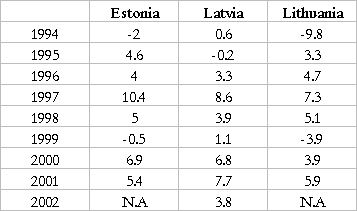
Source: Ministry of Finance, Central Statistical Bureau, Latvia; Lithuanian Department of Statistics, Ministry of Economics: and Bank of Estonia 2002, and Lahijas Unibanka, 2003.
Table-A2: Russia's Trade with Baltic States
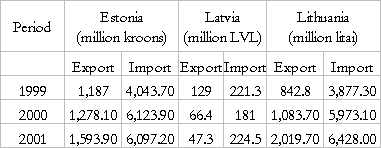
Source: Ministry of Finance Central Statistical Bureau, Latvia; Lithuanian Department of Statistics, Ministry of Economics, Bank of Estonia, Goscomstat (Russia).
Table-A3: Agreements Signed Between Baltic States and India 1993-2001
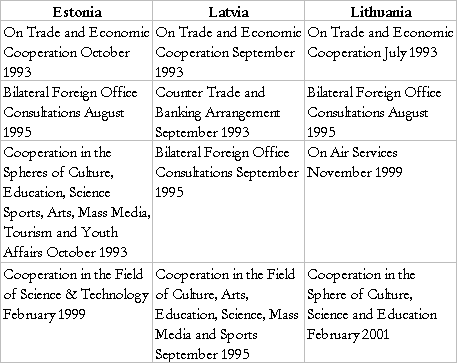
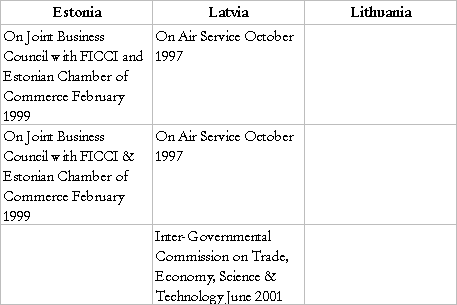
Source:Ministry of External Affairs, Central and Eastern Europe Division, New Delhi, 2003; Indian Embassy in Helsinki (Finland) 2003.
Table: A4 Agreements Under Consideration Between Baltic States and India
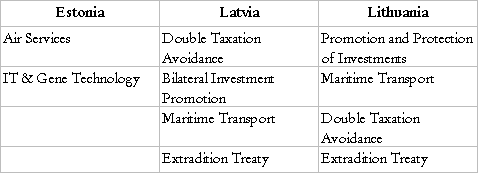
Source: Ministry of External Affairs, Central and Eastern Europe Division, New Delhi, 2003; Indian Embassy in Helsinki (Finland) 2003.
Table-A5: Bilateral Trade Depicting the Trend of Commercial Relationship with India (US$ Million)
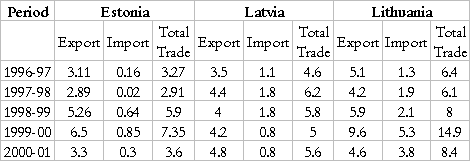
Source: State Committee for Statistics and Analysis of Lithuania, Latvia and Statistical Office of Estonia, DGCI & S, MEA, India 2003.
Major items of import from the Baltic region are paper and paper board, manufactured articles, raw hides and skins, machinery, chemical materials, electronic goods, organic chemicals, electrical machinery, printed books, wood and wood products, transport equipment, etc.
Major items of export are pulses, cotton yarn, fabrics, drugs, pharmaceuticals and fine chemicals, marine products, leather footwear, electronic goods, machinery and instruments, inorganic, orgasmic and agrochemicals, rubber manufactured products, leather goods, RMG cotton including accessories, tea, plastics, natural silk yarn, residual chemicals and allied products, cosmetics, toiletries, gems and jewelry, castor oil, groundnut, spirit and beverages, handicrafts, glass and glass ware, ceramics and cement, handmade carpets, transport equipment, etc.
Indian Technical and Economic Cooperation Programme (ITEC): Under the Indian Technical and Economic Cooperation Programme (ITEC), since 1993-94 till 2001-2002, several nominees from the Baltic region have attended various courses in the fields of diplomacy, banking, mass communications, financial management, urban development management, foreign trade, auditing, etc., in India.
Table-A6: Slots Under the ITEC Programme
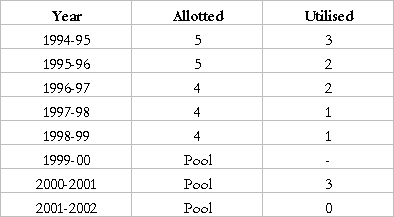
Source: Ministry of External Affairs, Central and Eastern Europe Division, New Delhi, and Honarary Consulates of Estonia, Latvia and Lithuania in New Delhi, 2003.
Illegal Immigrants: Till 1998, 241 Indians have been repatriated to India. Since 1999, the number has gone down but still 34 Indians were repatriated back till the end of 2001. (Information collected from the Ministry of External Affairs, Central & Eastern Europe Division, New Delhi; from Latvian Honorary Consulate in New Delhi, and from the Indian Embassy in Helsinki).
Annexure-3
Baltic States' Views Over Iraq War
The Baltic states of Lithuania, Latvia, and Estonia are among the countries that have voiced support for the United States in its war against Iraq. Politicians in the Baltic states explained their decision by citing longstanding warm relations with the US and saying the US is the only country that can offer them solid security guarantees. The three states look at the current rifts over Iraq in the European Union and NATO as the 'family quarrels' that will soon be resolved.
Latvia offered its official support for the US, following a discussion in the parliament. Although Latvia contributed no combat troops, the country was ready to send members of its armed forces for peacekeeping operations following the war. The first reason for Latvia to side with the United States, rather than France or Germany, was to do with country's history. The second reason was the constant sympathy for the Iraqi people based on Latvians' own experience of living under a dictatorship.
Lithuania offered its troops for peacekeeping in a post-war scenario. The arguments for supporting the US according to them were that from September 11, 2001, Lithuania took part in the anti-terrorist coalition. Secondly, they felt the current action to be a part of the war on terror. Lithuania is also one of the most active NATO candidates and their attitude has always been consistent in supporting US actions. The US has also always supported Lithuania in its drive to join NATO.
There are other historical reasons too. As Lithuanian President, Algirdas Brazauskas and other Baltic leaders signed the Baltic Charter with the United States, it became the first security guarantee. That is why they have chosen this path and did not want to be involved in the 'family quarrels' in the NATO alliance. On the other hand, they are concerned that these quarrels may amount to some kind of political divorce.
Lithuanian leaders also believe that they have not made any mistake in opposing EU members (France and Germany), despite the fact that they are opting to join the bloc next year. France took a skeptical position last summer towards the problem of Russian transit through Lithuania from the Russian enclave of Kaliningrad. Though its position was rather unfriendly towards Lithuania, this decision was not a revenge against France. However, they feel, Lithuania's position on Iraq is unlikely to affect ratification of the EU accession treaties in France and Germany.
For Estonia, as the war did not concern it directly, it supported the US- led campaign because Iraq has failed to meet the nuclear disarmament obligations set out in the United Nations Resolution 1441. The Estonian parliament thought that they have to choose between the bad option and the worse option. The Estonians are certainly not warmongers and they believe neither are the Americans. As for the European Union's opinion over Iraq, Estonia did not want to take sides, but wants to see trans-Atlantic unity restored as soon as possible. 52
Endnotes
Note *: Nivedita Das Kundu is an Associate Fellow at IDSA. Her area of research is Russia and the countries of former Soviet Union. She is presently working on the Baltic states. She visited the three Baltic states from November 2002 to January 2003 to collect material and get first hand information on these countries. She has submitted her PhD thesis at the Centre for Russian, Central Asian and East European Studies, School of International Studies, Jawaharlal Nehru University, New Delhi. She has written extensively on her area of study in national and international journals. Back.
Note 1: Gronick, Ritva and Laura Paivi, Eds. 21st Century Challenges for the Baltic Sea Region and European Security. 2000. Nordic Forum of Security Policy; Helsinki. pp. 16-19. Back.
Note 2: Deryabin, J.S., Baltiya-Transevropickiy Koridor. 2000, 21 95-96. Back.
Note 3: Kruzich, Joseph P. and Anna Fahraeus, Eds.Towards an Exclusive Security Structure in the Baltic Sea Region. 1998. Swedish Institute of International Affairs; Stockholm p.140. Back.
Note 4: Basics of National Security of Lithuania. Vilinius. 1996. LMOD; Riga. Back.
Note 5: http://www.mod.gov./ lith/ ee/english/sec-politika/htm. Back.
Note 6: Security Concept of the Republic of Latvia. 1997. LMOD; Riga. Back.
Note 7: http:/www.mod.lv/sec-politica/drosibas.htm Back.
Note 8: Ibid.; Yael Tamir, Liberal Nationalism. 1993. Princeton University Press; Princeton. pp. 159-162. Back.
Note 9: Guidelines of the National Defence Policy of Estonia. 1996. EMOD; Tallinn. Back.
Note 10: Ibid.; http://www.mod.gov.ee./english Back.
Note 11: Feldman, Marje, European Integration and the Discourse of National Identity in the Baltic States. National Identities. 2001, 3 (1) 5-12. Back.
Note 12: Bauwens, Werner, Armand Clesse and Olav F. Knudsen, Eds. Small States and Security Challenge in the New Europe. 1996. Brasseys; London. p.124. Back.
Note 13: Smith, Graham, Vibian Law, Andrew Wilson, Eds. Nation Building in Post- Soviet Borderlands:The Politics of National Identities. 1998. Cambridge University Press; Cambridge. pp. 61-67. Also cited in Eiki Berg, Writing Post-Soviet Estonia into the World Map. Working Paper 3, 2000. COPRI; Copenhagen. p.15 Back.
Note 14: Bebler, Anton A., Eds. The Challenge of the NATO Enlargement. 1999. Praeger; Westport. p. 6. Back.
Note 15: Ries, Tomas, Ed. NATO Tommorow. Research Report. 2000, 2 (7) Department of Strategic and Defence Studies; Helsinki. 50-54 Back.
Note 16: Hopkinson, William, Enlargement a New NATO. 2001. Institute for Security Studies; Paris. pp. 69-71. Back.
Note 17: Lejivs, A., and D. Bleirere, Eds. The Baltic States' Search of Security. 1998. Latvian Institute of International Affairs; Riga. pp. 82-87. Back.
Note 18: Ozolina, Z., Ed. Small States in a Turbulent Environment: The Baltic Perspective. 1998. Latvian Institute of International Affairs; Riga. pp. 108-121. Back.
Note 19: Arnswald, Sven, and Mathias Jopp, The Implications of Baltic States EU Membership. 2001. Institute for European Politics; Berlin. pp. 11-15. Back.
Note 20: Baltic Survey. January 1996; Karoliina Honkanen and Tomas Reis, Baltic Security, NATO and EU. Occasional Papers. 2001, (1) Atlantic Council of Finland; Helsinki. pp. 24-25; Hans Mouritzen, Ed. Bordering Russia: Theory and Prospects for Europe's Baltic Rim.1998. Ashgate; London. p. 176. Back.
Note 21: Moroff, Holger, Ed. European Soft Security Policies; The Northern Dimensions. 2000. Institute for European Politics; Berlin. pp. 324-325. Back.
Note 22: European Commission Group Report no. 6. White Paper on Governance; Policies for an Enlarged Union. 2001. European Commission; Brussels. pp. 22-24. Back.
Note 23: Report on Russia and the Baltic States. Appendix E. 2002. Council on Foreign and Defense Policy; Moscow. pp. 139-147. Back.
Note 24: Hubel, Helmut, Ed. EU Enlargement and Beyond: The Baltic States and Russia. 2002. Berlin Verlag; Berlin. pp. 323-340; Iver Neumann, Russia and the Idea of Europe: A Study in Identity and International Relations.1996. Routledge; London. Back.
Note 25: Joenniemi, P., and Stalvent C.E., Eds. Baltic Sea Politics. Achievements and Challenges. 1995. Nord REFO; Stockholm. pp. 55-75. Back.
Note 26: Ibid.; The Europe World Yearbook. 2002, 1&2. pp. 2435, 1508, 2532. Back.
Note 27: Organising National Defences for NATO Membership. 2001, Harmon Paper no.15. Center for European Security Studies; Groningen. pp.47-49. Back.
Note 28: Heinemann-Gruder, Andreas, Small States-Big Stories: Choice and Purpose in the Security Policies of the Baltic States. 2002. Brief 21. International Center for Conversion; Bonn. pp. 37-38. Back.
Note 29: Olav, F., Ed. "Security and Cooperation in the Baltic Sea Region." 2000. Workshop at the Swedish Institute of International Affairs. 2000. Bonn. at http:/www.sh.se/statsvetenskap/larar/document/olfwp/olf.htm Back.
Note 30: "Database for Baltic States" at: http:/ www.vm.bl/baltica. Back.
Note 31: Reports on the Progress Towards Accession by Each of the Candidate Countries, November 1999. European Union Commission; Brussels; Arkady Moshes, The Double Enlargement, Russia and the Baltic States. Working Paper 2002/4, ISSN No. 1397-3002. 2002, Danish Institiute of International Affairs; Copenhagen. pp. 18-19. Back.
Note 32: Oznobishchev, S., and I. Yurgens, Eds. Rossia-Baltia. 2001. CFDP Reports. Moscow. pp. 133-138. Back.
Note 33: Lejins, A., and Z. Ozolina, Eds. Small States in a Turbulent Environment: The Baltic Perspective. 1997. Latvian Institute of International Affairs; Riga. pp. 113-147. Back.
Note 34: Carsnaes,W., and S. Smith, Eds. European Foreign Policy: The EC and Changing Perspective in Europe. 1994. Sage; London. pp. 156-177. Back.
Note 35: Poloskova, Tatiana, Diaspora IVneshniaya Politika. Mezhdunarodnaya Zhizn. 1999, 11 71-80. Back.
Note 36: Pozdorovkin, V. G., and U.S. Arutiunov, Kaliningradskii Faktor v Sotrudnichestve Rossii so Stranami Baltiiskogo Regiona. Diplomaticheskii Vestnik. 2000, (1) 67-70. Back.
Note 37: Westlund, Hans, Alexander Granberg, Folke Snickars, Eds. Regional Development in Russia. 2000. The Swedish Institute for Regional Research; Sweden. pp. 45-47. Back.
Note 38: Gronick, Ritva, Meri Kulmala, Laura Palivio, Eds. Russia, Kaliningrad Oblast and the Baltic Sea Region. 2000. The Finnish Committee for European Security; Helsinki. pp. 88-92. Back.
Note 39: Gower, J., and J. Redmond, Ed. Enlarging the European Union: The Way Forward. 2000. Aledershot; Brookfield. pp.163-169. Back.
Note 40: Baxendale, James, Stephen Dewar, and David Gowan, Eds. The EU and Kaliningrad. 2000. Kogan Page Ltd.; European Union. pp.143-147. Back.
Note 41: Paul, Holtom and Fabrizio Tassinari, Russian Participation in Baltic Sea Region-Building: A Case Study of Kaliningrad. 2002. Humbolt Universitat; Berlin. pp. 25-31. Back.
Note 42: Information collected from Ministry of External Affairs, The Russian Federation, November-December 2002. Back.
Note 43: Reports of the Russian Council on Foreign and Defense Policy, Rossija I Pribaltika. at http://www.svorp.ru/doklad8.htm July 6, 2001; Goskomstat Rossia v Tsifrach. 2000, Moscow. Back.
Note 44: Address of I. Ivanov, Minister of Foreign Affairs of The Russian Federation, in the at the EU Conference on Northern Dimension. Diplomaticheskiy Vestnik. 1999, (12) 9-10. Back.
Note 45: Human Rights and Social Integration in the Republic of Lithuania. National Report. 1998. Lithuanian Ministry of Foreign Affairs, Lithuanian Naturalisation Board, UNDP Lithuania. Back.
Note 46: Human Rights Aspects of the Citizenship Issues in Estonia and Latvia. Progress Report based on available material and visit on February 3-7, March 11, 1992; Boris Tsilevich in Jarve, Priit and Wellmann Christian, Report on ECMI Baltic Seminar on Minorities and Majorities in Estonia: Problems of Integration on the Threshold of EU. 1999. Aabenra/Denmark and Flensburg/Germany, May 22-25,1998 ECMI Report no. 1 Flensburg: European Center for Minority Issues, 26. Back.
Note 47: Central Eurasia; Foreign Policy Concept of the Russian Federation. FBIS Report. March 25, 1993. Back.
Note 48: Knudsen, O.F., and I.B. Neuman, Subregional Security Cooperation in the Baltic Sea Area. Research Report.1995. Norwegian Institute of International Affairs; Oslo. p.189; D. Bungs, Russia Agrees to Withdraw Troops from Latvia. Radio Free Europe/ Radio Liberty Research Report. June 22, 1994. Back.
Note 49: Baltic States Report. May 24, 2002, 3 (17). Back.
Note 50: Opinion Survey Published in a Monograph of Holger Moroff on The New North of Europe. 2002. FIIA; Helsinki. p.66. Back.
Note 51: Views expressed by various political personalities of these states during the interview conversation with them in November-December 2002. Back.
Note 52: http://www.ncsj.org/Aug Pages/032003 Baltics: html; http://www.Balticadata.info; http:// www.vm.ee/Estonia. Back.